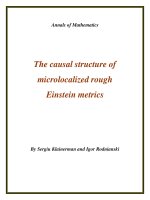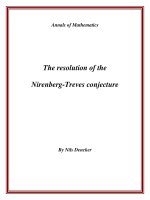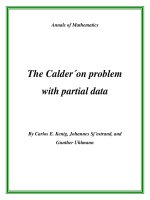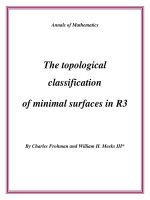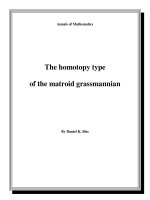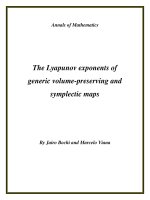Đề tài "The Erd˝os-Szemer´edi problem on sum set and product set" ppt
Bạn đang xem bản rút gọn của tài liệu. Xem và tải ngay bản đầy đủ của tài liệu tại đây (199.13 KB, 20 trang )
Annals of Mathematics
The Erd˝os-Szemer´edi
problem on sum set and
product set
By Mei-Chu Chang*
Annals of Mathematics, 157 (2003), 939–957
The Erd˝os-Szemer´edi problem
on sum set and product set
By Mei-Chu Chang*
Summary
The basic theme of this paper is the fact that if A is a finite set of integers,
then the sum and product sets cannot both be small. A precise formulation of
this fact is Conjecture 1 below due to Erd˝os-Szemer´edi [E-S]. (see also [El], [T],
and [K-T] for related aspects.) Only much weaker results or very special cases
of this conjecture are presently known. One approach consists of assuming
the sum set A + A small and then deriving that the product set AA is large
(using Freiman’s structure theorem) (cf. [N-T], [Na3]). We follow the reverse
route and prove that if |AA| <c|A|, then |A + A| >c
|A|
2
(see Theorem 1). A
quantitative version of this phenomenon combined with the Pl¨unnecke type of
inequality (due to Ruzsa) permit us to settle completely a related conjecture
in [E-S] on the growth in k.If
g(k) ≡ min{|A[1]| + |A{1}|}
over all sets A ⊂
of cardinality |A| = k and where A[1] (respectively, A{1})
refers to the simple sum (resp., product) of elements of A. (See (0.6), (0.7).) It
was conjectured in [E-S] that g(k) grows faster than any power of k for k →∞.
We will prove here that ln g(k) ∼
(ln k)
2
ln ln k
(see Theorem 2) which is the main
result of this paper.
Introduction
Let A, B be finite sets of an abelian group. The sum set of A, B is
(0.1) A + B ≡{a + b | a ∈ A, b ∈ B}.
We denote by
(0.2) hA ≡ A + ···+ A (h fold)
the h-fold sum of A.
*Partially supported by NSA.
940 MEI-CHU CHANG
Similarly we can define the product set of A, B and h-fold product of A.
AB ≡{ab | a ∈ A, b ∈ B},(0.3)
A
h
≡ A ···A (h fold).(0.4)
If B = {b},asingleton, we denote AB by b · A.
In 1983, Erd˝os and Szemer´edi [E-S] conjectured that for subsets of integers,
the sum set and the product set cannot both be small. Precisely, they made
the following conjecture.
Conjecture 1 (Erd˝os-Szemer´edi). For any ε>0 and any h ∈
there
is k
0
= k
0
(ε) such that for any A ⊂
with |A|≥k
0
,
(0.5) |hA ∪ A
h
||A|
h−ε
.
We note that there is an obvious upper bound |hA∪A
h
|≤2
|A| + h −1
h
.
Another related conjecture requires the following notation of simple sum
and simple product.
A[1] ≡
k
i=1
ε
i
a
i
| a
i
∈ A, ε
i
=0 or 1
,(0.6)
A{1}≡
k
i=1
a
ε
i
i
| a
i
∈ A, ε
i
=0 or 1
.(0.7)
For the rest of the introduction, we only consider A ⊂
.
Conjecture 2 (Erd˝os-Szemer´edi). Let g(k) ≡ min
|A|=k
{|A[1]|+|A{1}|}.
Then for any t, there is k
0
= k
0
(t) such that for any k ≥ k
0
,g(k) >k
t
.
Toward Conjecture 1, all work has been done so far, are for the case h =2.
Erd˝os and Szemer´edi [E-S] got the first bound:
Theorem (Erd˝os-Szemer´edi). Let f(k) ≡ min
|A|=k
|2A ∪A
2
|. Then there
are constants c
1
,c
2
, such that
(0.8) k
1+c
1
<f(k) <k
2
e
−c
2
ln k
ln ln k
.
Nathanson showed that f(k) >ck
32
31
, with c =0.00028 .
At this point, the best bound is
(0.9) |2A ∪ A
2
| >c|A|
5/4
obtained by Elekes [El] using the Szemer´edi-Trotter theorem on line-incidences
in the plane (see [S-T]).
THE ERD
˝
OS-SZEMER
´
EDI PROBLEM
941
On the other hand, Nathanson and Tenenbaum [N-T] concluded some-
thing stronger by assuming the sum set is small. They showed
Theorem (Nathanson-Tenenbaum). If
(0.10) |2A|≤3|A|−4,
then
(0.11) |A
2
|
|A|
ln |A|
2
.
Very recently, Elekes and Ruzsa [El-R] again using the Szemer´edi-Trotter
theorem, established the following general inequality.
Theorem (Elekes-Ruzsa). If A ⊂
is a finite set, then
(0.12) |A + A|
4
|AA|ln|A| > |A|
6
.
In particular, their result implies that if
(0.13) |2A| <c|A|,
then
(0.14) |A
2
|
|A|
2
c
ln |A|
.
For further result in this direction, see [C2].
Related to Conjecture 2, Erd˝os and Szemer´edi [E-S] have an upper bound:
Theorem (Erd˝os-Szemer´edi). Let g(k) ≡ min
|A|=k
{|A[1]|+|A{1}|}. There
is a constant c such that
(0.15) g(k) <e
c
(ln k)
2
ln ln k
.
Our first theorem is to show that the h-fold sum is big, if the product is
small.
Theorem 1. Let A ⊂
be a finite set. If |A
2
| <α|A|, then
(0.16) |2A| > 36
−α
|A|
2
,
and
(0.17) |hA| >c
h
(α)|A|
h
.
Here
(0.18) c
h
(α)=(2h
2
− h)
−hα
.
942 MEI-CHU CHANG
Our approach is to show that there is a constant c such that
(0.19)
m∈A
e
2πimx
2h
dx<c|A|
h
by applying an easy result of Freiman’s theorem (see the paragraph after
Proposition 10) to obtain
(0.20) A ⊂ P ≡
a
b
a
1
b
1
j
1
···
a
s
b
s
j
s
0 ≤ j
i
<
i
and carefully analyzing the corresponding trigonometric polynomials (see
Proposition 8). These are estimates in the spirit of Rudin [R]. The constant c
here depends, of course, on s and h.
In order to have a good universal bound c,weintroduce the concept
of multiplicative dimension of a finite set of integers, and derive some basic
properties of it (see Propositions 10 and 11). We expect more applications
coming out of it.
Another application of our method together with a Pl¨unnecke type of
inequality (due to Ruzsa) gives a complete answer to Conjecture 2.
Theorem 2. Let g(k) ≡ min
|A|=k
{|A[1]| + |A{1}|}. Then there is ε>0
such that
(0.21) k
(1+ε)
ln k
ln ln k
>g(k) >k
(
1
8
−ε)
ln k
ln ln k
.
Remark 2.1 (Ruzsa). The lower bound can be improved to k
(
1
2
−ε)
ln k
ln ln k
.
We will give more detail after the proof of Theorem 2.
Using a result of Laczkovich and Rusza, we obtain the following result
related to a conjecture in [E-S] on undirected graphs.
Theorem 3. Let G ⊂ A × A satisfy |G| >δ|A|
2
. Denote the restricted
sum and product sets by
A
G
+ A = {a + a
|(a, a
) ∈ G}(0.22)
A
G
× A = {aa
|(a, a
) ∈ G}.(0.23)
If
(0.24) |A
G
× A| <c|A|,
then
(0.25) |A
G
+ A| >C(δ, c)|A|
2
.
THE ERD
˝
OS-SZEMER
´
EDI PROBLEM
943
The paper is organized as follows:
In Section 1, we prove Theorem 1 and introduce the concept of multi-
plicative dimension. In Section 2, we show the lower bound of Theorem 2
and Theorem 3. In Section 3, we repeat Erd˝os-Szemer´edi’s upper bound of
Theorem 2.
Notation. We denote by a the greatest integer ≤ a, and by |A| the
cardinality of a set A.
Acknowledgement. The author would like to thank J. Bourgain for various
advice, and I. Ruzsa and the referee for many helpful comments.
1. Proof of Theorem 1
Let A ⊂
beafinite set of positive integers, and let Γ
h,A
(n)bethe
number of representatives of n by the sum of h (ordered) elements in A, i.e.,
(1.1) Γ
h,A
(n) ≡
{(a
1
, ,a
h
) |
a
i
= n, a
i
∈ A}
.
The two standard lemmas below provide our starting point.
Lemma 3. Let A ⊂
be finite and let h ∈ .Ifthere is a constant c
such that
(1.2)
n∈hA
Γ
2
h,A
(n) <c|A|
h
,
then
(1.3) |hA| >
1
c
|A|
h
.
Proof. Cauchy-Schwartz inequality and the hypothesis give
|A|
h
=
n∈hA
Γ
h,A
(n) ≤|hA|
1/2
n∈hA
Γ
2
h,A
(n)
1/2
< |hA|
1/2
c
1/2
|A|
h/2
.
Lemma 4. The following equality holds:
n∈hA
Γ
2
h,A
(n)=
m∈A
e
2πimx
2h
2h
.
944 MEI-CHU CHANG
Proof.
m∈A
e
2πimx
2h
2h
=
m∈A
e
2πimx
2h
dx
=
m∈A
e
2πimx
h
2
dx
=
n∈hA
Γ
h,A
(n)e
2πinx
2
dx
=
n∈hA
Γ
2
h,A
(n).
The last equality is Parseval equality.
From Lemmas 3 and 4, it is clear that to prove Theorem 1, we want to
find a constant c such that
(1.4)
m∈A
e
2πimx
2h
2
<c|A|.
In fact, we will prove something more general to be used in the inductive
argument.
Proposition 5. Let A ⊂
be a finite set with |A
2
| <α|A|. Then for
any {d
a
}
a∈A
⊂
+
,
(1.5)
a∈A
d
a
e
2πiax
2h
2
<c
d
2
a
for some constant c depending on h and α only.
Foraprecise constant c, see Proposition 9.
The following proposition takes care of the special case of (1.5) when there
exists a prime p such that for every nonnegative integer j, p
j
appears in the
prime factorization of at most one element in A.Itisalso the initial step of
our iteration.
First, for convenience, we use the following:
Notation. We denote by G
+
, the set of linear combinations of elements
in G with coefficients in
+
.
THE ERD
˝
OS-SZEMER
´
EDI PROBLEM
945
Proposition 6. Let p be a fixed prime, and let
(1.6) F
j
(x) ∈
e
2πip
j
nx
n ∈
, (n, p)=1
+
.
Then
(1.7)
j
F
j
2h
2
≤ c
h
j
F
j
2
2h
, where c
h
=2h
2
− h.
Proof. To bound
|
j
F
j
|
2h
dx,weexpand |
j
F
j
|
2h
as
(1.8)
F
j
h
F
j
h
.
Let
(1.9) F
j
1
···F
j
h
F
j
h+1
···F
j
2h
beaterm in the expansion of (1.8). After rearrangement, we may assume
j
1
≤···≤j
h
, and j
h+1
≤ ···≤j
2h
.
When (1.9) is expressed as a linear combination of trignometric functions,
atypical term is of the form
(1.10) ne
2πix(p
j
1
n
1
+···+p
j
h
n
h
−p
j
h+1
n
h+1
−··−p
j
2h
n
2h
)
.
We note that the integral of (1.10) is 0, if the expression in the parenthesis
in (1.10) is nonzero. In particular, independent of the n
i
’s, the integral of (1.10)
is 0, if
(1.11)
j
1
= j
2
≤ j
h+1
, or j
1
= j
h+1
≤ min{j
2
,j
h+2
}, or j
h+1
= j
h+2
≤ j
1
.
Therefore, if any of the statements in (1.11) is true, then the integral of (1.9)
is 0.
We now consider the integral of (1.9) where the index set {j
1
, ,j
2h
} does
not satisfy any of the conditions in (1.11). For the case j
1
= j
2
≤ j
h+1
,wesee
that in an ordered set of h elements coming from the expansion of (1.8) (before
the rearrangement), there are exactly
h
2
choices for the positions of j
1
,j
2
.On
the other hand, if F
j
1
F
j
2
is factored out, the rest is symmetric with respect to
j
3
, ,j
h
, and j
h+1
, ,j
2h
, i.e., all the terms involving j ≡ j
1
= j
2
≤ j
h+1
are simplified to
(1.12)
h
2
(F
j
)
2
k≥j
F
k
h−2
.
With the same reasoning for the other two cases, we conclude that
946 MEI-CHU CHANG
j
F
j
2h
2h
=
h
2
j
F
2
j
k≥j
F
k
h−2
k≥j
F
k
h
dx
+ h
2
j
|F
j
|
2
k≥j
F
k
k≥j
F
k
h−1
dx
+
h
2
j
F
2
j
k≥j
F
k
h
k≥j
F
k
h−2
dx.
The right-hand side is
≤
h
2
+2
h
2
j
|F
j
|
2
k≥j
F
k
2h−2
dx
≤ (2h
2
− h)
j
F
2
j
h
k≥j
F
k
2h−2
h
h−1
=(2h
2
− h)
j
F
j
2
2h
k≥j
F
k
2h
2h−2
.
The last inequality is H¨older inequality.
Now, the next lemma concludes the proof of Proposition 6.
Lemma 7. Let F
k
∈{e
2πim
k
x
| m
k
∈ }
+
. Then
(1.13)
k
F
k
2h
≥
k≥j
F
k
2h
, for any j.
Proof.
k
F
k
2h
dx
=
k≥j
F
k
+
k<j
F
k
···
k≥j
F
k
+
k<j
F
k
k≥j
F
k
+
k<j
F
k
···
k≥j
F
k
+
k<j
F
k
dx
≥
k≥j
F
k
k≥j
F
k
h
dx =
k≥j
F
k
2h
2h
.
THE ERD
˝
OS-SZEMER
´
EDI PROBLEM
947
The inequality holds because the coefficients of the trignometric functions (as
in (1.10)) in the expansion are all positive.
Remark 7.1. This is a special case of a general theorem in martingale
theory.
Proposition 8. Let p
1
, ···,p
t
be distinct primes, and let
(1.14) F
j
1
, ,j
t
(x) ∈
e
2πip
j
1
1
···p
j
t
t
nx
n ∈
, (n, p
1
···p
t
)=1
+
.
Then
(1.15)
j
1
, ,j
t
F
j
1
, ,j
t
2
2h
≤ c
t
h
j
1
, ,j
t
F
j
1
, ,j
t
2
2h
, where c
h
=2h
2
− h.
Proof. We do induction on t. The left-hand side of (1.15) becomes
j
1
j
2
, ,j
t
F
j
1
, ,j
t
2
≤ c
h
j
1
j
2
, ,j
t
F
j
1
, ,j
t
2
≤ c
h
j
1
c
t−1
h
j
2
, ,j
t
F
j
1
, ,j
t
2
,
which is the right-hand side.
Proposition 5 is proved, if we can find a small t such that the Fourier
transform of F
j
1
, ,j
t
is supported at one point and such t is bounded by α.So
we introduce the following notion.
Definition. Let A beafinite set of positive rational numbers in lowest
terms (cf. (0.20)). Let q
1
, ,q
be all the prime factors in the obvious prime
factorization of elements in A.Fora ∈ A, let a = q
j
1
j
···q
j
be the prime
factorization of a. Then the map ν : A →
by sending a to (j
1
, ,j
)is
one-to-one. The multiplicative dimension of A is the dimension of the smallest
(affine) linear space in
containing ν(A).
We note that for any nonzero rational number q, q · A and A have the
same multiplicative dimension, since ν(q · A)isatranslation of ν(A).
The following proposition is a more precise version of Lemma 5.
Proposition 9. Let A ⊂
be finite with mult.dim(A)=m. Then
(1.16)
a∈A
d
a
e
2πiax
2h
2
<c
m
h
d
2
a
, where c
h
=2h
2
− h.
Proof. To use (1.15) in Proposition 8, we want to show that there are
primes q
1
, ,q
m
such that a term of the trigonometric polynomial in the
948 MEI-CHU CHANG
left-hand side of (1.15), when expressed in terms of the notation in (1.14), is
F
j
1
, ,j
m
= d
a
e
2πiq
j
1
1
···q
j
m
m
nx
.Inother words, we want to show that among the
prime factors q
1
, ,q
of elements in A, there are m of them, say q
1
, ,q
m
such that
(∗) for all (j
1
, ,j
m
) ∈
m
, there is at most one a ∈ A such that
q
j
1
1
···q
j
m
m
is part of the prime factorization of a. This is equivalent to
(∗∗) π ◦ ν is injective, where ν is as in the definition of multiplicative
dimension and π :
→
m
is the projection to the first m coordinates.
Since dim ν(A)=m,(∗∗)isclear after some permutation of the q
i
’s.
Proposition 10. Let A ⊂ be finite with mult.dim A = m. Then
(1.17)
n∈hA
Γ
2
h,A
(n) <c
mh
h
|A|
h
, where c
h
=2h
2
− h.
Proof. This is a consequence of Lemma 4 and Proposition 9 (with
d
a
= 1).
The hypothesis of Theorem 1 gives a universal bound on the multiplicative
dimension of A by applying Freiman’s theorem (cf. [Fr1], [Fr2], [Fr3], [Bi], [C1],
[Na1]). In fact, we do not need the full content of the Freiman’s theorem, but a
much easier result by Freiman. A small modification (over
instead of over )
of Lemma 4.3 in [Bi] is sufficient. (As Ruzsa pointed out it is also Lemma 1.14
in [Fr1].)
Theorem (Freiman). Let G ⊂
beasubgroup and A
1
⊂ G be finite. If
there is a constant α, α<
|A
1
|, such that |2A
1
| <α|A
1
|, then there is an
integer
s ≤ α
such that A
1
is contained in an s-dimensional proper progression P
1
; i.e., there
exist β,α
1
, ,α
s
∈ G and J
1
, ···,J
s
∈ such that
A
1
⊂ P
1
= {β + j
1
α
1
+ ···+ j
s
α
s
| 0 ≤ j
i
<J
i
},
and |P
1
| = J
1
···J
s
.
Note that if |A
1
| >
αα+1
2(α+1−α)
, then s ≤α − 1.
Recall that the full Freiman theorem also permits one to state a bound
J
1
···J
s
<c(α)|A
1
|.However this additional information will not be used in
what follows.
We would like to work on a sum set instead of a product set. So we define
(1.18) A
1
≡ ln A = {ln a | a ∈ A}.
Note that ln is an isomorphism between the two groups (
+
, ·) and (ln
+
, +).
THE ERD
˝
OS-SZEMER
´
EDI PROBLEM
949
Applying the theorem to A
1
⊂ ln
+
, then pushing back by (ln)
−1
,we
have
(1.19) A ⊂ P ≡
a
b
(
a
1
b
1
)
j
1
···(
a
s
b
s
)
j
s
| 0 ≤ j
i
<J
i
⊂
+
,
where a, b, a
i
,b
i
,J
i
∈ , and (a, b)=1, (a
i
,b
i
)=1. Moreover, s ≤α −1 and
different ordered sets (j
1
, ···,j
s
) represent different rational numbers. Clearly,
(1.20) mult. dim A ≤ mult.dim P = dim E ≤ s ≤α − 1,
where E is the vector space generated by ν(
a
1
b
1
), ···,ν(
a
s
b
s
).
Therefore, we have
Proposition 11. Let A ⊂
be a finite set. If |A|
2
<α|A| for some con-
stant α, α<|A|
1/2
, then mult.dim A ≤ α.Furthermore, if |A| >
αα+1
2(α+1−α)
,
then mult.dim A ≤α − 1.
Putting Propositions 10 and 11 together, we have
Proposition 12. Let A ⊂
be finite. If |A
2
| <α|A| for some constant α,
α<|A|
1/2
, then
n∈hA
Γ
2
h,A
(n) <c
αh
h
|A|
h
, where c
h
=2h
2
− h.
Now, Theorem 1 follows from Proposition 12 and Lemma 3.
2. Simple sums and products
In this section we will prove the lower bound in Theorem 2.
Let A ⊂
be finite. We define
(2.1) g(A) ≡|A[1]|+ |A{1}|,
where A[1] and A{1} are the simple sum and simple product of A. (See (0.6),
(0.7) for precise definitions.)
We will show that for any ε and any A ⊂
with |A| = k 0,
(2.2) g(A) >k
(
1
8
−ε)
ln k
ln ln k
.
For those who like precise bounds, we show:
For 0 <ε
1
,ε
2
<
1
2
,
(2.3) g(A) >e
−3
k
1
2
−ε
2
(
1
4
−
ε
1
2
)
ln k
ln ln k
,
950 MEI-CHU CHANG
if |A| = k is large enough such that
(2.4) ln lnk>
√
2
8ε
1
,
and
(2.5)
ln k
ln lnk
>
2
ε
2
.
Proposition 13. Let B ⊂
be finite with mult.dim B = m. Then for
any h
1
∈
,
(2.6) |h
1
B ∩ B[1]| >
|B|
(2h
2
1
− h
1
)
m+1
h
1
.
Proof. Since h
1
B ∩ B[1] is the set of simple sums with exactly h
1
sum-
mands, we have
(2.7)
|B|
h
1
≤
n∈h
1
B∩B[1]
Γ
h
1
,B
(n).
Therefore,
|B|
h
1
h
1
< (h
1
B ∩ B[1])
1/2
n∈h
1
B
Γ
2
h
1
,B
(n)
1/2
≤ (h
1
B ∩ B[1])
1/2
[(2h
2
1
− h
1
)
mh
1
|B|
h
1
]
1/2
.
The first inequality is because of the Cauchy-Schwartz inequality and the fact
that h
1
B ∩ B[1] ⊂ h
1
B. The second inequality is Proposition 10.
Remark 13.1. Clearly, from our proof, the denominator in (2.6) can be
replaced by (2h
2
1
− h
1
)
m
h
2
1
.
Proposition 14. Let B ⊂
with |B|≥
√
k and mult.dim B = m.For
any 0 <ε
1
<
1
2
, if
(2.8) m +1≤
1
4
−
ε
1
2
ln k
ln lnk
,
then
(2.9) g(B) >k
ε
1
ln k
√
2
.
Proof. Inequality (2.8) is equivalent to
(2.10) (ln k)
2m+2
≤ k
1/2−ε
1
.
THE ERD
˝
OS-SZEMER
´
EDI PROBLEM
951
In Proposition 13, we take h
1
=
ln k
√
2
. This gives
(2.11) 2h
2
1
≤ (ln k)
2
.
Combining (2.11), (2.10) and (2.6), we have
g(B) > |h
1
B ∩ B[1]| >
k
1/2
k
1/2−ε
1
ln k
√
2
= k
ε
1
ln k
√
2
.
Remark 14.1. Let A ⊂ with |A| = k, k 0 (see (2.4)). The set B
in Proposition 14 will be taken as a subset of A. Then the bound in (2.9) is
bigger than that in (2.2), and our proof is done. Therefore for the rest of the
section, we assume
(2.12) mult.dimB ≥(
1
4
−
ε
2
2
)
ln k
ln lnk
, for any B ⊂ A with |B| >
√
k.
We need the following:
Notation. We denote B
≡ ν(B) for any B ⊂ A, where ν = A →
is as
in the definition of multiplicative dimension.
Note that
(2.13) |B
[1]| = |B{1}|.
We will use the following Pl¨unnecke type of inequality due to Ruzsa.
Ruzsa’s Inequality [Ru2]. For any h, ∈
:
If |M + N |≤ρ|M|, then |hN −N|≤ρ
h+
|M|.
Proof of (2.2). We divide A into
√
k pieces B
1
,B
2
, ···, each of cardi-
nality at least
√
k.For0<ε
2
<
1
2
, let
(2.14) ρ =1+k
−1/2+ε
2
,
and let
(2.15) A
s
≡
s
i=1
B
i
.
There are two cases:
(i) For all s, |(A
s
B
s+1
)
[1]| >ρ|A
s
[1]|. Iterating gives
(2.16) |A
[1]| = |(B
1
∪ B
2
∪···)
[1]| >ρ
√
k−2
√
k.
952 MEI-CHU CHANG
Therefore
g(A) > |A{1}| = |A
[1]| >e
(
√
k−2)ln ρ+
1
2
ln k
(2.17)
>e
(
√
k−2)
4
5
k
−1/2+ε
2
+
1
2
ln k
>e
4
5
k
ε
2
.
Inequality (2.5) is equivalent to
k
ε
2
> (ln k)
2
.
which is certainly stronger than what we need to show (2.2).
(ii) There exists s such that |(A
s
∪ B
s+1
)
[1]|≤ρ|A
s
[1]|.Weuse the
fact that (A
s
∪ B
s+1
)
[1] = A
s
[1] + B
s+1
[1], and Ruzsa’s inequality (with h =
h
2
+1,=1)toobtain
(2.18) |(h
2
+1)B
s+1
[1] − B
s+1
[1]|≤ρ
h
2
+2
|A
s
[1]|.
Let m =mult.dimB
s+1
.Foraset B, for h ∈
, denote
(2.19) B[h] ≡
ε
i
x
i
| ε
i
=0, ,h,x
i
∈ B
.
The left-hand side of (2.18) is
≥|h
2
B
s+1
[1]|(2.20)
≥|B
s+1
[h
2
]|
≥ h
m
2
.
We take h
2
= k
1/2−ε
2
. Then in the right-hand side of (2.18),
ρ
h
2
+2
≤ (1 + k
−1/2+ε
2
)
k
1/2−ε
2
+2
(2.21)
< (e
k
−1/2+ε
2
)
k
1/2−ε
2
+2
<e
3
.
Therefore, (2.18), (2.20) and (2.21) imply
g(A) >g(A
s
)
> |A
s
[1]|
>e
−3
h
m
2
>e
−3
k
1/2−ε
2
(
1
4
−
ε
1
2
)
ln k
ln ln k
.
The last inequality follows from our choice of h
2
and Remark 14.1.
Proof of Remark 2.1. In Proposition 14, if we take B with |B|≥
k
2
, then
we will replace (2.8), and (2.9) by
(2.8
) m +1≤
1
2
(1 − ε
1
)
ln k
ln lnk
,
THE ERD
˝
OS-SZEMER
´
EDI PROBLEM
953
and
(2.9
) g(B) >
k
ε
1
2
ln k
√
2
.
Let
m
0
=
1
2
(1 − ε
1
)
ln k
ln lnk
.
Then (2.12) will be replaced by
(2.12
)mult.dimB ≥ m
0
, for any B ⊂ A with |B| >
k
2
.
Now we modify the proof of (2.2).
Since |A| = k>
k
2
,wehave mult.dimA ≥ m
0
.Sothere is B
1
⊂ A
with mult.dimB
1
= m
0
and |B
1
| = m
0
+1. Similarly, we have B
2
⊂ A − B
1
with mult.dimB
2
= m
0
and |B
2
| = m
0
+1.Wecontinue this process until
r>
k
2(m
0
+1)
.Wehave
A ⊃ B
1
∪···∪B
r
with
mult.dimB
i
= m
0
,
and
|B
i
| = m
0
+1.
With more replacements,
(2.5
)
ln k
ln lnk
>
3
ε
2
.
and
(2.14
) ρ =1+k
−1+ε
2
,
Identical arguments give
g(A) >e
−3
k
1−ε
2
(
1
2
−
ε
1
2
)
ln k
ln ln k
.
Sketch of Proof of Theorem 3. Let |A| = N . Then the Laczkovich-Ruzsa
theorem [L-R] and (0.24) give A
1
⊂ A with
(2.22) |A
1
A
1
| <c
N,
and
(2.23) |G ∩ (A
1
× A
1
)| >δ
N
2
.
The weak Freiman theorem and (2.22) imply
(2.24) mult.dimA
1
<c
.
954 MEI-CHU CHANG
It follows from Proposition 10 (with h =2)and the proof of Lemma 4 that
(2.25) β ≡|{(n
1
,n
2
,n
3
,n
4
) ∈ A
4
1
|n
1
− n
2
+ n
3
− n
4
=0}| < 36
c
N
2
.
Hence
(2.26) δ
N
2
<
n∈A
1
G
+A
1
|{(n
1
,n
2
) ∈ A
2
1
|n = n
1
+ n
2
}| < |A
1
G
+ A
1
|
1
2
β
1
2
.
The first inequality is (2.23), while the second one is the Cauchy-Schwartz
inequality.
Therefore, (2.25) and (2.26) give
|A
G
+ A|≥|A
1
G
+ A
1
|≥
(δ
)
2
N
4
β
>CN
2
.
3. The example
In this section for completeness we repeat a family of examples by Erd˝os-
Szemer´edi which provide the upper bound in Theorem 2. Precisely, we will
show
Proposition 15. Given ε
3
> 0, for J so large that
(3.1)
ln J
ln lnJ
>
1
ε
3
,
there is a set A of cardinality |A| = k ≡ J
J
, such that
(3.2) g(A) < 2k
(1+ε)
ln k
ln ln k
,
where
(3.3) ε =3ε
3
+ ε
2
3
.
The example really comes from the proof of the lower bound of Theorem 2.
Let p
1
, ···,p
J
be the first J primes, and let
(3.4) A ≡
p
j
1
1
···p
j
J
J
| 0 ≤ j
i
<J
.
Then
(3.5) k ≡|A| = J
J
.
We will use the following relations between k and J.
THE ERD
˝
OS-SZEMER
´
EDI PROBLEM
955
Lemma 16. Let k, J be as in (3.5). Then
(i) ln k = Jln J.
(ii) ln ln k =lnJ +lnlnJ.
If J and ε
3
satisfy (3.1), then
(iii) ln ln k<(1 + ε
3
)ln J.
(iv) J<(1 + ε
3
)
ln k
ln ln k
.
(v) J
2
< (1 + ε
)(
ln k
ln ln k
)
2
, where ε
=2ε
3
+ ε
2
3
.
Proof. Each one follows immediately from the preceding one. For (iii)
implying (iv), we use J =
ln k
ln J
.
Remark 16.1. The inequality
ln J
ln ln J
>
1
ε
3
clearly implies
(3.6)
ln k
ln lnk
>
1
ε
3
.
Lemma 17. (i) For all a ∈ A, a<(ln k)
J
2
,
(ii) |A[1]| <k(ln k)
J
2
,
(iii) |A{1}| < (kJ)
J
.
Proof. (i) For a ∈ A, (3.4) gives
a<
i<J
p
i
J
<
i<J
iln i
J
<
J
J
(ln J)
J
J
=(Jln J)
J
2
= (ln k)
J
2
.
The second inequality is by the Prime Number Theorem. The last equality is
Lemma 16 (i).
(ii) follows from (i).
(iii) We see that
(3.7) A{1} =
p
k
s=1
j
(s)
1
1
···p
k
s=1
j
(s)
J
J
| 0 ≤ j
(s)
i
<J
.
Since
k
s=1
j
(s)
i
<kJ, (iii) holds.
956 MEI-CHU CHANG
Proof of Proposition 15. Lemma 17 (ii) and Lemma 16 (v) give
|A[1]| <k(ln k)
(1+ε
)(
ln k
ln ln k
)
2
(3.8)
= e
ln k+(1+ε
)
(ln k)
2
ln ln k
= e
ln k(1+(1+ε
)
ln k
ln ln k
)
<e
ln k(1+ε)
ln k
ln ln k
= k
(1+ε)
ln k
ln ln k
.
Here ε = ε
+ ε
3
=3ε
3
+ ε
2
3
.Weuse (3.6) for the last inequality.
Lemmas 17 (iii), 16 (iv), and (3.5) give
|A{1}| <k
J
k = k
J+1
<k
(1+ε
3
)
ln k
ln ln k
+1
(3.9)
<k
(1+2ε
3
)
ln k
ln ln k
.
The last inequality is again by (3.6).
Putting (3.8) and (3.9) together, we have g(A) < 2k
(1+ε)
ln k
ln ln k
.
University of California, Riverside, CA
E-mail address:
References
[Bi] Y. Bilu, Structure of sets with small sumset, in Structure Theory of Set Addition,
Ast´erisque 258 (1999), 77–108.
[C1]
M C. Chang,Apolynomial bound in Freiman’s theorem, Duke Math. J . 113 (2002),
399–419.
[C2]
,Factorization in generalized arithmetic progressions and applications to the
Erd¨os-Szemer´edi sum-product problems, GAFA,toappear.
[El]
G. Elekes,Onthe number of sums and products, Acta Arith. 81 (1997), 365–367.
[El-R]
G. Elekes and I. Ruzsa, Product sets are very large if sumsets are very small, preprint.
[E]
P. Erd
˝
os, Problems and results on combinatorial number theory. III, in Number
Theory Day, 43–72 (Proc. Conf. Rockefeller Univ ., New York , 1976), Lecture Notes
in Math. 626, Springer-Verlag, New York, 1977.
[E-S]
P. Erd
˝
os and E. Szemer
´
edi,Onsums and products of integers, Studies in Pure
Mathematics, Birkh¨auser, Basel, 1983, 213–218.
[Fr1]
G. A. Freiman, Foundations of a Structural Theory of Set Addition, Transl. of Math.
Monographs 37,A.M.S., Providence, RI, 1973.
[Fr2]
,Onthe addition of finite sets. I, Izv. Vysh. Ucheb. Zaved. Matematika 13
(1959), 202–213.
[Fr3]
,Inverse problems of additive number theory. VI. On the addition of finite
sets. III, Izv. Vysh. Ucheb. Zaved. Matematika 28 (1962), 151–187.
[H-T]
R. R. Hall and G. Tenenbaum, Divisors, Cambridge Tracts in Math. 90, Cambridge
Univ. Press, Cambridge, 1988.
[K-T]
N. Katz and T. Tao, Some connections between Falconer’s distance set conjecture
and sets of Furstenberg type, New York J. Math. 7 (2001), 149–157.
THE ERD
˝
OS-SZEMER
´
EDI PROBLEM
957
[L-R] M. Laczkovich
and I. Z. Ruzsa
, The number of homothetic subsets, in The Mathe-
matics of P. Erd˝os, II (R. L. Graham and J. Nesetril, eds.), Springer-Verlag, New
York, 1977, 294–302.
[Na1]
M. B. Nathanson
, Additive Number Theory. Inverse Problems and the Geometry of
Sumsets, Grad. Texts in Math. 165, Springer-Verlag, New York, 1996.
[Na2]
, The simplest inverse problems in additive number theory, in Number Theory
with an Emphasis on the Markloff Spectrum (Provo, UT, 1991), 191–206, Marcel
Dekker, New York, 1993.
[Na3]
,Onsums and products of integers, Proc. Amer. Math. Soc. 125 (1997),
9–16.
[N-T]
M. Nathanson and G. Tenenbaum,Inverse theorems and the number of sums and
products, in Structure Theory of Set Addition, Ast´erisque 258 (1999), 195–204.
[P]
H. Pl
¨
unnecke, Eine zahlentheoretische Anwendung der Graphtheorie, J. Reine
Angew. Math. 243 (1970), 171–183.
[R]
W. Rudin,Trigonometric series with gaps, J. Math. Mech. 9 (1960), 203–227.
[Ru]
I. Z. Ruzsa
, Generalized arithmetical progressions and sumsets, Acta Math. Hungar .
65 (1994), 379–388.
[Ru2]
, Sums of finite sets, in Number Theory (New York, 1991–1995), Springer-
Verlag, New York, 1996.
[S-T]
E. Szemer
´
edi and W. Trotter, Extremal problems in discrete geometry, Combina-
torica 3 (1983), 381–392.
[T]
T. Tao,From rotating needles to stability of waves: emerging connections between
combinatorics, analysis, and PDE, Notices Amer. Math. Soc. 48 (2001), 294–303.
(Received November 27, 2001)


